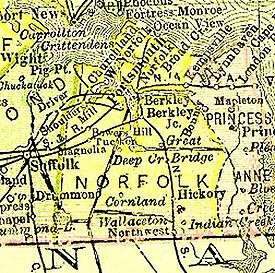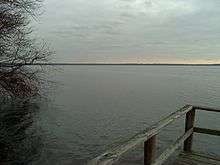History of Chesapeake, Virginia

| History of Virginia |
|---|
|
|
|
In 1963, the new independent city of Chesapeake was created when the former independent city of South Norfolk consolidated with Norfolk County. The consolidation, authorized by the Virginia General Assembly, was approved and the new name selected by the voters of each communities by referendum. The new city is part of the current region of Hampton Roads which are linked by the circumferential Hampton Roads Beltway.
Formed in 1691 in the Virginia Colony, Norfolk County had originally included essentially all the area which became the towns and later cities of Norfolk, Portsmouth, and South Norfolk, but had seen its area frequently reduced as these cities added territory through annexations after 1871. Becoming an independent city was a method for the former county to stabilize borders with neighbors, as cities could not annex territory from each other.
The relatively small City of South Norfolk had become an incorporated town within Norfolk County in 1919, and became an independent city in 1922. It was also motivated to make a change which would put it on a more equal footing in other aspects with the much larger cities of Norfolk and Portsmouth. By the late 1950s, although immune from annexation by the bigger cities, the most recent suit by the City of Norfolk against Norfolk County would have taken all of the county land adjoining South Norfolk.
The changes which created Chesapeake were part of a wave of changes in the structure of local government in southeastern Virginia which took place between 1952 and 1976.
Chesapeake's history goes far back into Virginia's colonial roots. The Intracoastal Waterway passes through Chesapeake. On the waterway, at Great Bridge where the locks transition from the Southern Branch Elizabeth River to the Chesapeake and Albemarle Canal lies the site of the Battle of Great Bridge. This American Revolutionary War battle was responsible for removing Lord Dunmore and any other vestige of English Government for the Colony of Virginia during the early days of the American Revolution on December 9, 1775.

The Dismal Swamp Canal runs through Chesapeake as well. The site of this canal was surveyed by George Washington, among others, and is known as "Washington's Ditch". It is the oldest continuously used man made canal in the United States today and has been in service for over 230 years. The canal begins in the Deep Creek section of the city branching off from the Southern Branch Elizabeth River. The canal runs through Chesapeake paralleling U.S. Highway 17 into North Carolina and connects to Elizabeth City, North Carolina.
Until the late 1980s and early 1990s, much of Chesapeake was either suburban or rural, serving as a bedroom community of the adjacent cities of Norfolk and Virginia Beach with residents commuting to these locations. Beginning in the late 1980s and accelerating in the 1990s, however, Chesapeake saw significant growth, attracting numerous and significant industries and businesses of its own. This explosive growth quickly led to strains on the municipal infrastructure, ranging from intrusion of saltwater into the city's water supply to congested roads and schools.
Chesapeake made national headlines in 2003 when, under a court-ordered change of venue, the community hosted the first trial of convicted murderer Beltway sniper Lee Boyd Malvo for one of the 2002 terrorist-style attacks. A jury spared him a potential death sentence, choosing a sentence of "life in prison without parole" instead for the young man, who was 17 years old at the time of the crime spree. A jury in neighboring Virginia Beach sentenced his older partner John Allen Muhammad to death for another of the attacks.
See also
- Norfolk County, Virginia
- South Norfolk, Virginia
- Beltway Sniper Attacks
- Tobacco and Slaves: The Development of Southern Cultures in the Chesapeake, 1680–1800 (book)